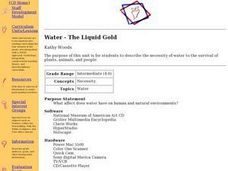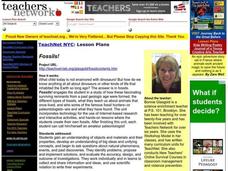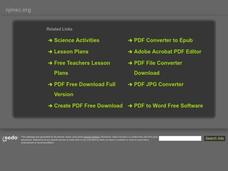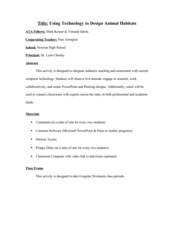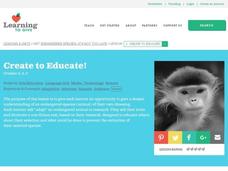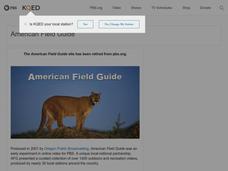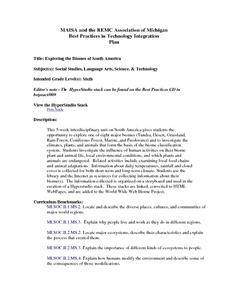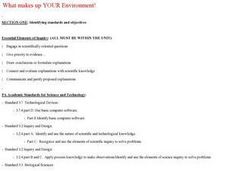Curated OER
Return Of The Living Dead
Students research endangered animal species that have 'beaten the odds' as they continue to survive longer than scientists had expected. They write individual pages for a class book about endangered species.
Curated OER
How about a Little Give and Take?
Students design a closed system to test the relationships between plants and animals. They monitor abiotic fluctuations within this living system by using a chemical test kit. They observe how living organisms respond to fluctuations in...
Curated OER
Water-The Liquid Gold
Students investigate the necessity of water for the survival of plants, animals, and people. They explore the affect that water has on human and natural environments through literature, field trips, and discussions.
Curated OER
What's All the Buzz About
Students participate in a game of charades to examine different animal behaviors. After reading an article, they discuss why bees waggle and how that behavior applies to humans. They research the behaviors of an animal of interest to...
Curated OER
Fossils!
Students conduct Internet research about different types of fossils, the animals they are from, and some famous paleontologists. They also participate in some interactive activities and hands-on lessons in which they create their own...
Curated OER
Classification and Identification
Students, after exploring and analyzing diagrammatic and taxonomic keys and their association to marine sciences, identify and classify objects and organisms based on visual attributes/characteristics. They research and create their own...
Curated OER
Diseases You Can Catch
In this communicable diseases activity, students research 26 diseases and determine which are caused by viruses and which are caused by bacteria. After researching, they complete 11 short answer questions about signs and symptoms of the...
Curated OER
Weave an Aquatic Food Web
Students explore organisms that are part of interconnected food webs. In this food web lesson, students choose an animal and research what the animal eats. Students begin with the food chain and branch out into the...
Curated OER
Dinosaur Detectives
Young scholars write a report about a paleontologist. In this paleontology instructional activity, students research and write a report about a noted paleontologist. They discuss the importance of technology to paleontologists and how...
Curated OER
Using Technology to Design Animal Habitats
Young scholars study the relationship between an animal and where it lives. In this habitats lesson students research to obtain data and create a professional report.
Curated OER
Dalai Lama: Day 2 of 5
Sixth graders explore philosophy by researching the Dalai Lama. In this Tibetan history lesson, 6th graders discuss the influence of Buddhism on the Dalai Lama and the unique view on life a Buddhist must have. Students read a Tibetan...
Curated OER
Savanna Hands-On Biome Building
Fifth graders participate in an interdisciplinary project related to the Savanna biome. For this biome building lesson, 5th graders display the elements of the Savanna biome such as the geography, animals and plants, and...
Curated OER
Endangered Species... It's Not Too Late
Students choose an endangered species to research and report on. In this endangered species lesson, students complete a worksheet to gather information about their endangered animal and then use to write a book about the animal and...
Curated OER
The Formation and Value of Temperate Grasslands
Students get an overview of the climate and organisms of the North American Prairie. After a lecture, and watching some videos imbedded in this plan, students compile research data on the North American Prairie.
Curated OER
Migrating Across Borders
Learners research and map the migratory patterns of the golden-winged warbler. They develop a strategy to protect this species and, in teams representing different countries, negotiate treaties with each other to protect the bird.
Curated OER
Migration Mania
Learners explore the migratory patterns of four different animals. Reasons for the migration and migratory distances are investigated in this instructional activity.
Curated OER
Characteristics of Snakes and Turtles
Students examine the characteristics of snakes and turtles and compare/contrast reptiles with mammals. They watch a video, answer discussion questions, complete information charts, conduct Internet research, and create a habitat diorama.
Curated OER
Food Webs
Students produce a newspaper covering topics related to food webs. They use print and electronic sources to gather information about specific animals. They share their information with the class.
Curated OER
Exploring the Biomes of South America
Sixth graders complete a five-week unit investigating the eight major biomes of South America. They conduct Internet research, collect short-term and long-term climate data, and create a HyperStudio slideshow stack about a selected biome...
Curated OER
Coral Reefs
Students research an inhabitant of a Caribbean coral reef using a list of common organisms that live on or near it. Students then write a description of their organism and draw a picture or a 3-D model of it. Eventually they all work...
Curated OER
Food Web Mobile
Students explain the main concepts of food webs and food chains. They
describe the role of animals, plants, and other organisms in cycling energy and matter through a food web by creating mobiles. Lesson contains adaptations for all levels.
Alabama Learning Exchange
Animal Classification
Present information about the classification of animals. After participating in the teacher-led discussion about scientific names, small groups devise their own way of classifying everyday objects present in the classroom, developing...
Curated OER
Monarch Migration
Third graders investigate the life cycle of the Monarch butterfly. They experiment with various tools to simulate the mouth parts of insects, conduct research, record their observations of butterflies hatching, write a play, complete...
Curated OER
What makes up YOUR Environment!
Students create their own land or water environment. They make their environment livable for all the different animals they collect to put in it. Students research the types of animals that they can have in their environment, and how...


